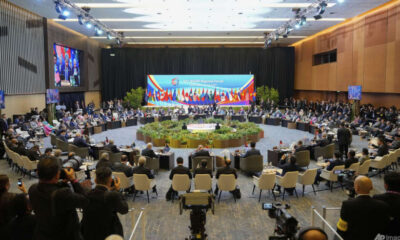Entertainment
Singapore’s Cinema Crisis: The Fight for Survival in a Changing Landscape

The recent closures of significant cinema operators in Singapore have triggered concern and nostalgia among film enthusiasts. In August, independent cinema operator The Projector ceased operations due to escalating debts, prompting an outpouring of emotions. Many in the community shared memories of films viewed at the venue, while others signed petitions urging authorities to save the beloved establishment after a decade of service. Film distributor Vincent Quek highlighted that The Projector was not merely a place for arthouse films and documentaries; it also served as a cultural hub hosting various community events.
Just weeks later, another major player, Cathay Cineplexes, announced its voluntary liquidation on September 1, 2023, citing millions owed to landlords and stakeholders. This closure marked the end of one of Singapore’s oldest cinema chains, which had been in operation since before World War II. The combined losses of these two operators have ignited discussions about the future of movie theatres in Singapore, especially as they follow the exits of other chains like Eng Wah and Filmgarde.
Industry experts attribute these closures to a broader global trend where cinema attendance continues to decline. According to the European Audiovisual Observatory, global cinema attendance fell by 8.8 percent in 2024, reaching 4.8 billion admissions, the first annual decrease since the COVID-19 pandemic. This figure represents only 68 percent of attendance levels in 2019. In Singapore, the situation is even more dire, with a staggering 16 percent drop in cinema attendance, from 10 million in 2023 to 8.4 million in 2024. This decline is significant compared to the peak of 22.13 million admissions in 2011.
Despite these challenges, some industry players remain hopeful about the future of cinema. Local filmmaker M Raihan Halim noted that cinema has historically faced various struggles but has always found ways to adapt. He pointed to the 1980s, when home video systems like VHS threatened theatres, only for audiences to return as they missed the communal experience of watching films on the big screen.
The Infocomm Media Development Authority (IMDA) still describes Singapore as having “one of the highest per capita cinema attendances in the world,” which reinforces a sense of optimism among some industry stakeholders. The current attendance figures translate to approximately 1.39 tickets per person per year, which, while lower than France’s 2.73 and South Korea’s 2.39, is comparable to other developed markets.
Global Trends and Local Challenges
The recent turmoil in Singapore’s cinema landscape raises questions about how cinemas can survive and thrive in a changing environment. Observers have looked to international examples, particularly from countries like France, where cinema attendance has remained relatively robust. France recorded only a 1.7 percent decline in ticket sales from 2023 to 2024, with admissions rising to 181.3 million. This success is attributed to a strong domestic film industry, which captured 44.4 percent of the market share, and government policies that support local cinema operators.
In France, students are exposed to cinema from an early age, with public schools providing lists of films for viewing. The government also offers financial support through tax credits and funding, which is critical for the production of local films. The director of the award-winning film Anatomy of a Fall, Justine Triet, emphasized the importance of public funding in her acceptance speech for the Palme d’Or at the Cannes Film Festival in 2023.
In contrast, Singapore’s cinemas face higher operating costs and a more diverse population, which complicates the creation of broadly appealing local content. Experts highlight that while nations like Vietnam and Indonesia have thrived due to affordable ticket prices and a homogeneous culture, Singapore struggles with these dynamics. Cinemas in Indonesia saw a 10 percent increase in attendance in 2024, while Vietnam’s box office collection set a new record at US$184 million last year.
Filmmakers in Singapore contend with limited budgets and a small talent pool. Benjamin Ong, a freelance director of photography, noted that local productions typically involve fewer crew members than in other countries, limiting the scale of projects. This situation is exacerbated by competition for audiences from international films, particularly from larger film industries in China, India, and Malaysia.
Strategies for Recovery and Growth
While the challenges are significant, industry experts suggest that cinemas in Singapore can regain their former glory by adopting innovative strategies. One critical approach involves enhancing the overall cinema experience. Mr. Wang from EY pointed out that younger consumers, especially Gen Z, are more inclined to invest in unique experiences. This shift in consumer behavior necessitates that cinema operators rethink their offerings beyond just film screenings.
Potential strategies include providing luxurious seating akin to first-class airline experiences, incorporating state-of-the-art sound and projection technology, and creating immersive environments that replicate the comforts of home. Events like post-show Q&As with filmmakers, which the Singapore Film Society (SFS) has successfully implemented, can add value that streaming cannot offer. Their recent IMAX screening during the Japanese Film Festival saw record attendance, demonstrating that engaging events can attract audiences even when films are available online.
Improving the local filmmaking industry is equally important. Vincent Quek advocates for policies that ensure airtime for local films at cinema chains, perhaps coupled with government subsidies to lower ticket prices for local productions. Currently, the lack of visibility for local films limits opportunities for consumer engagement. The SFS noted that only two local films made it into the top ten grossing films in Singapore from 2019 to 2024.
Ultimately, industry players maintain that cinema’s resilience is proven. Mr. Tan of SFS emphasized that while industry shakeouts are inevitable, the cinema sector has historically bounced back from challenges, whether during financial crises or significant global events. With strategic adaptations, Singapore’s cinema scene may yet thrive once more in the evolving entertainment landscape.
-

 Lifestyle3 months ago
Lifestyle3 months agoHumanism Camp Engages 250 Youths in Summer Fest 2025
-

 Sports3 months ago
Sports3 months agoDe Minaur Triumphs at Washington Open After Thrilling Comeback
-

 Business4 months ago
Business4 months agoKenvue Dismisses CEO Thibaut Mongon as Strategic Review Advances
-

 Sports4 months ago
Sports4 months agoTupou and Daugunu Join First Nations Squad for Lions Clash
-

 Top Stories4 months ago
Top Stories4 months agoColombian Senator Miguel Uribe Shows Signs of Recovery After Attack
-

 World4 months ago
World4 months agoASEAN Gears Up for Historic Joint Meeting of Foreign and Economic Ministers
-

 Health3 months ago
Health3 months agoNew Study Challenges Assumptions About Aging and Inflammation
-

 Business4 months ago
Business4 months agoOil Prices Surge Following New EU Sanctions on Russia
-

 Entertainment3 months ago
Entertainment3 months agoDetaşe-Sabah Violin Ensemble Captivates at Gabala Music Festival
-

 Entertainment3 months ago
Entertainment3 months agoBaku Metro Extends Hours for Justin Timberlake Concert
-

 Business4 months ago
Business4 months agoU.S. House Approves Stablecoin Bill, Sends to Trump for Signature
-

 Top Stories4 months ago
Top Stories4 months agoRethinking Singapore’s F&B Regulations Amid Business Closures









